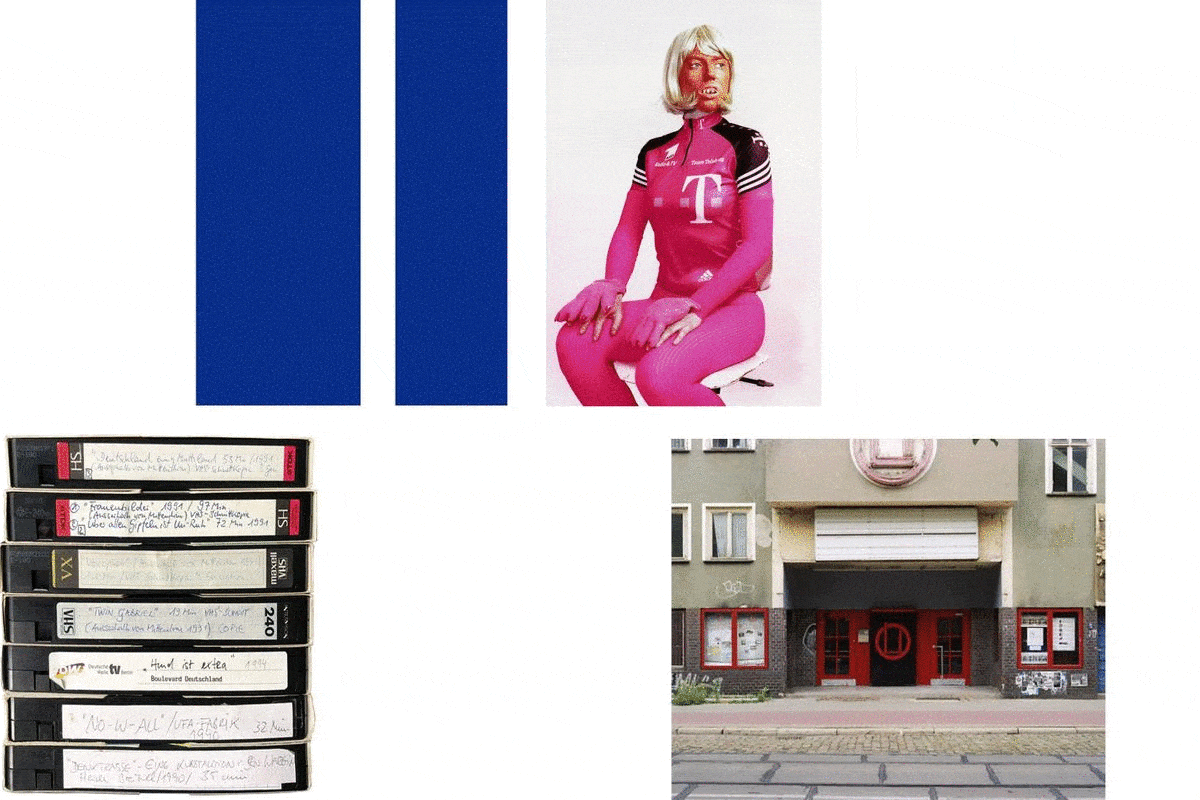Case studies on post-unification
September 16–November 7, 2021
1st floor, entrance via escalator
Karl-Liebknecht-Strasse 11/13
10178 Berlin
Germany
presse@ngbk.de
This research exhibition poses a number of questions regarding the encounter between art from East and West Germany after the re-unification: how did artists apply the working methods they developed in the late GDR to the new situation after 1990? What erasures or shifts of meaning did they enact or experience in the transferral of their practices and lives? Did certain methods and motifs become illegible through this transition, and how are these being taken up by a younger generation?
The exhibition is dedicated to East German artists’ ongoing search for a new and distinctive vocabulary.
Case study: “Paradies Leerstand”
September 16–22, Susanne Huth, Silke Koch, Suse Weber
Case study: “Muttiland Revisited”
September 23–29, Heide Bartholomäus & Gina Pietsch, Sabine Reinfeld
Case study: “Marlboro Man”
September 30–October 6, Bernd Hiepe, Eric Meier, Tucké Royale, Wolfgang H Scholz, Gabriele Stötzer
Case study: “Stasisauna”
October 7–13, Elske Rosenfeld, Wolfgang H Scholz
Case study: “Depot Bilderstau”
October 14–20, Nadja Buttendorf, Rainer Görß & Ania Rudolph, Margret Hoppe, Achim Valbracht
Case study: “Wessiwerdung”
October 21–27, Tina Bara, Can Candan, Yvon Chabrowski, Harun Farocki, Jörg Herold, Wilhelm Klotzek & Peter Woelck, Silke Koch, Wolfgang H Scholz, Gabriele Stötzer
Case study: “Ossiwerdung”
October 28–November 7, Minh Duc Pham, Andrea Pichl, David Polzin, Sophie Reinhold, Anna Zett & Hermann Heisig
An exhibition that both describes a movement and is itself in motion.
A scenography developed by Suse Weber structures the exhibition space into thematic sections. Spatial separations can be removed and new connections initiated. The exhibition continually reorders itself around a series of thematic foci over the course of the seven weeks.
One point of departure is the exhibition history of the nGbK in relation to the art of the post-GDR. A performance by Sabine Reinfeld, developed in and for the exhibition within the case study “Muttiland Revisited,” refers to a stage program shown in 1991 in the nGbK exhibition Outside of Centre. Susanne Huth’s photographic series “Gloria” (2005) show former cinemas in Magdeburg’s urban space that have been converted into supermarkets.
The case study “Stasisauna” looks at ways history in which inscribes itself in the body: early experimental films by Wolfgang H Scholz from the 1980s become the starting point for a collaborative artistic reworking with Elske Rosenfeld. After 1990, art from the GDR was mainly put into storage [German: Depot], in a rejection of the works’ artistic value. The photo series “The Disappeared Pictures (2003–2006)” by Margret Hoppe documents this process. Taking works out of storage—in order to let them speak once again—requires simultaneous work on the art-historical and curatorial vocabulary. In cooperation with the U144 Underground Museum on Linienstrasse in Berlin-Mitte, Rainer Görß will offer performative tours through the collection there, in which urban history, industrial culture and political ideology are recycled artistically.
The case study “Marlboro Man” takes on constructions of East German masculinities before/after 1989: In Kentaur (1988) Gabriele Stötzer’s camera turned the patriarchal tables, as her camera objectifies and sexualizes male bodies. By contrast, the body of a young man in Eric Meier’s W from 2019 lingers ambivalently between vulnerability and aggression. Tucké Royale’s poem MAN EY articulates a diasporic manhood, reconciling autobiographical transitions with a societally transformative experience.
The case study “Wessiwerdung” (Becoming Wessi) features a series of portraits by Tina Bara who, after her emigration to West Berlin, photographed the faces of other GDR émigrés. A new video work by Yvon Chabrowski analyses the process of othering of East Germans that occurred through the caricature of the Zonen-Gaby (Titanic) cover, (1989) and its reception. In Duvarlar - Mauern - Walls (2000) Can Candan documents how West Berliners of Turkish origin became third-class citizens after the fall of the Wall.
The case study “Ossiwerdung” (Becoming Ossi) explores the possibilities, frictions, misunderstandings and contradictions produced by the current valorisation of biography and identity. The project Resonanz (2020/21) by Anna Zett and Hermann Heisig proposes an improvisational format for personal, historical and speculative associations with the former German state, the GDR, in the exhibition space during the last week of the exhibition, to which participating artists are also invited.
nGbK project group: Bakri Bakhit, Elske Rosenfeld, Wolfgang H Scholz, Anna Voswinckel, Suse Weber
Further press information here.
Press contact:
neue Gesellschaft für bildende Kunst
Wayra Schübel
presse [at] ngbk.de


